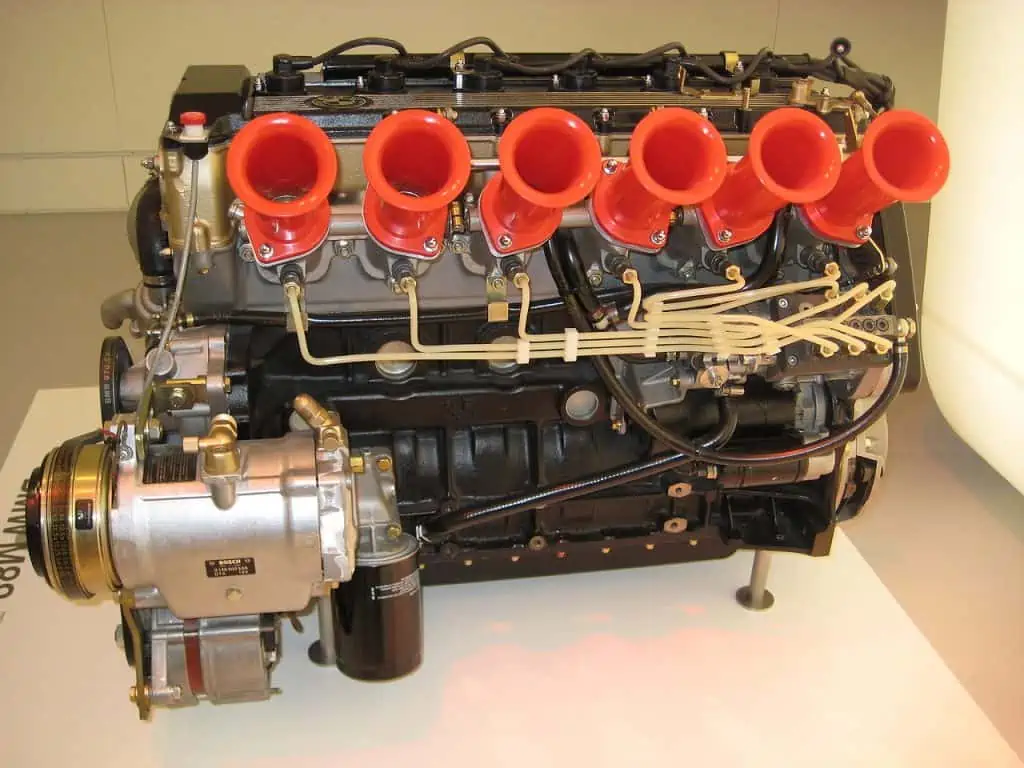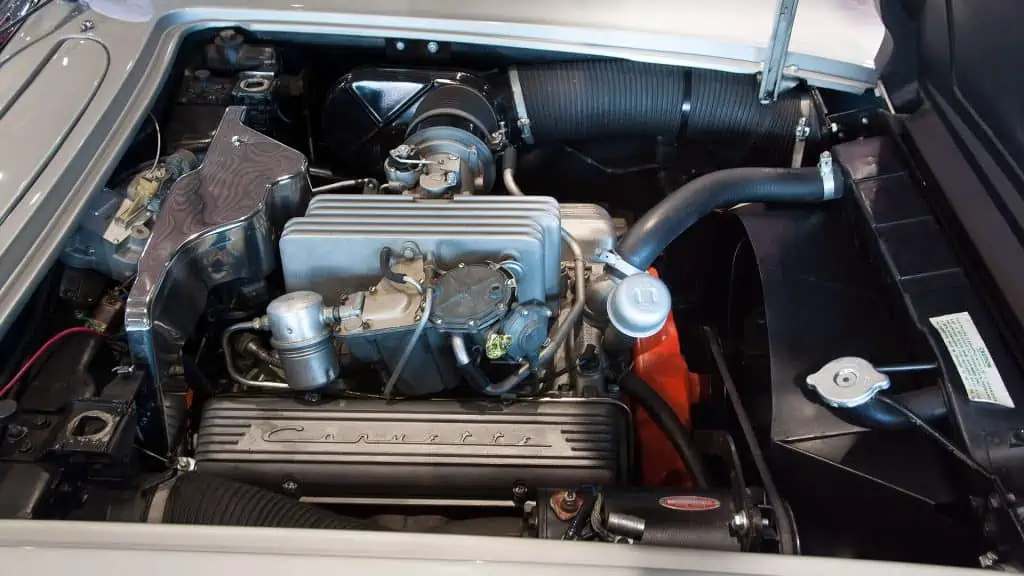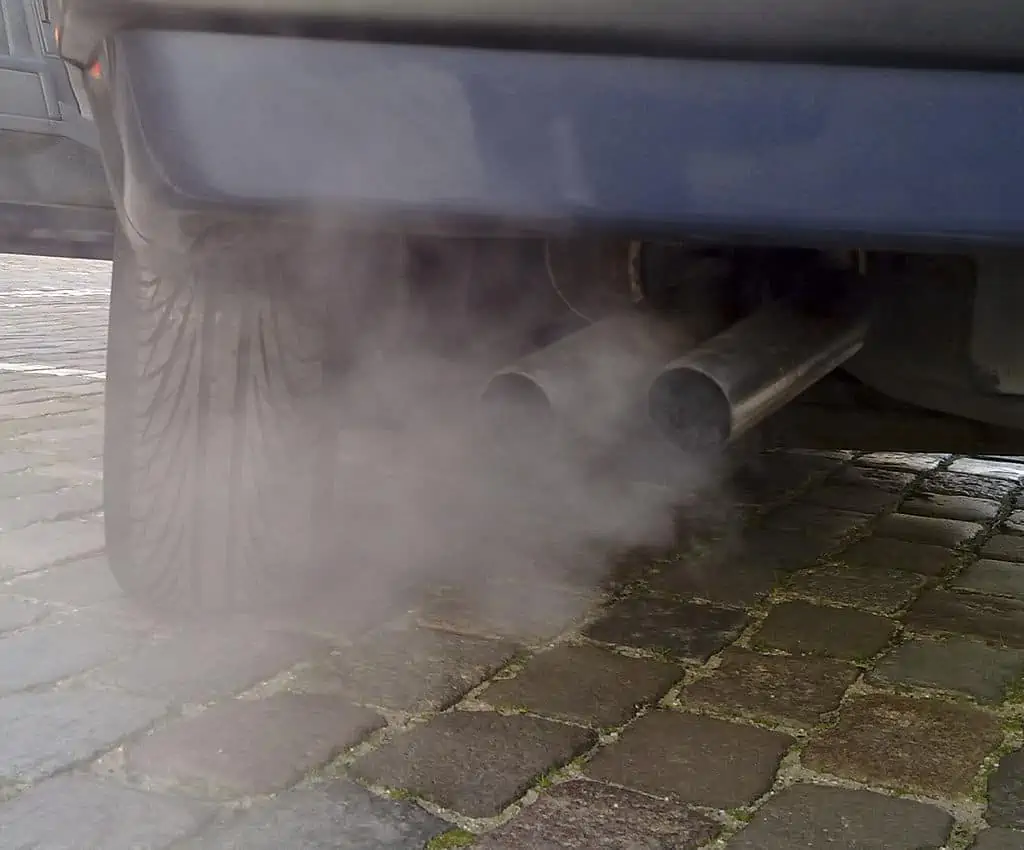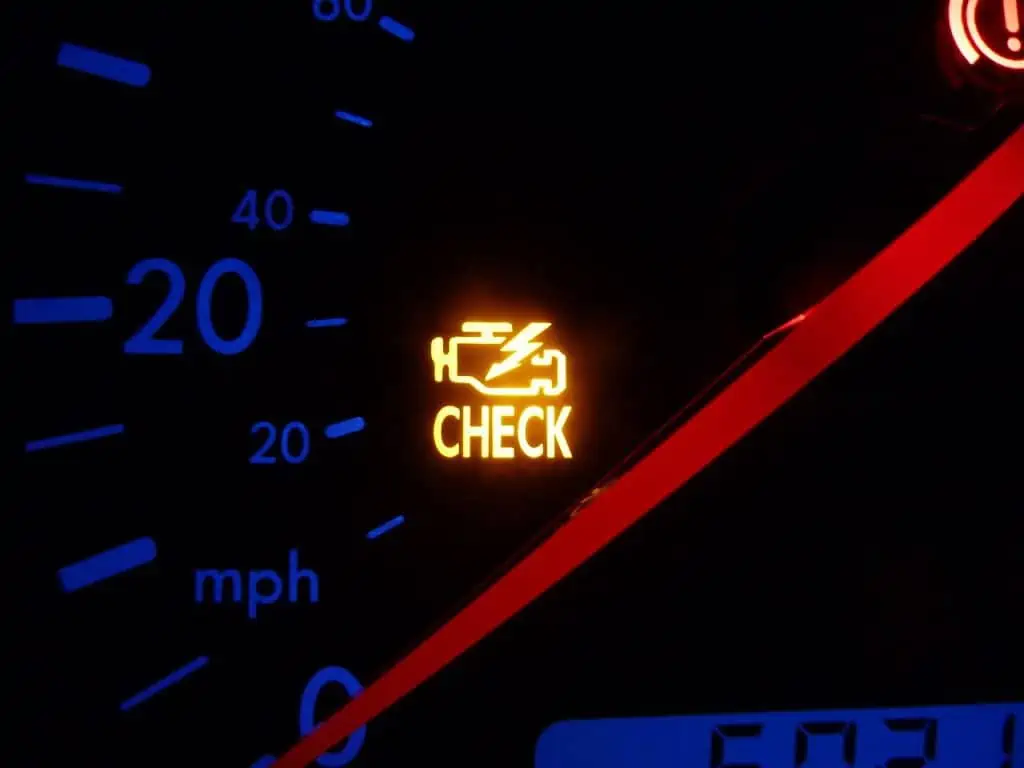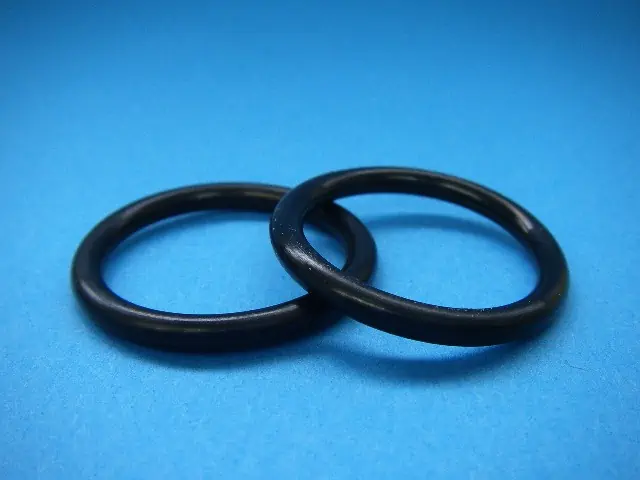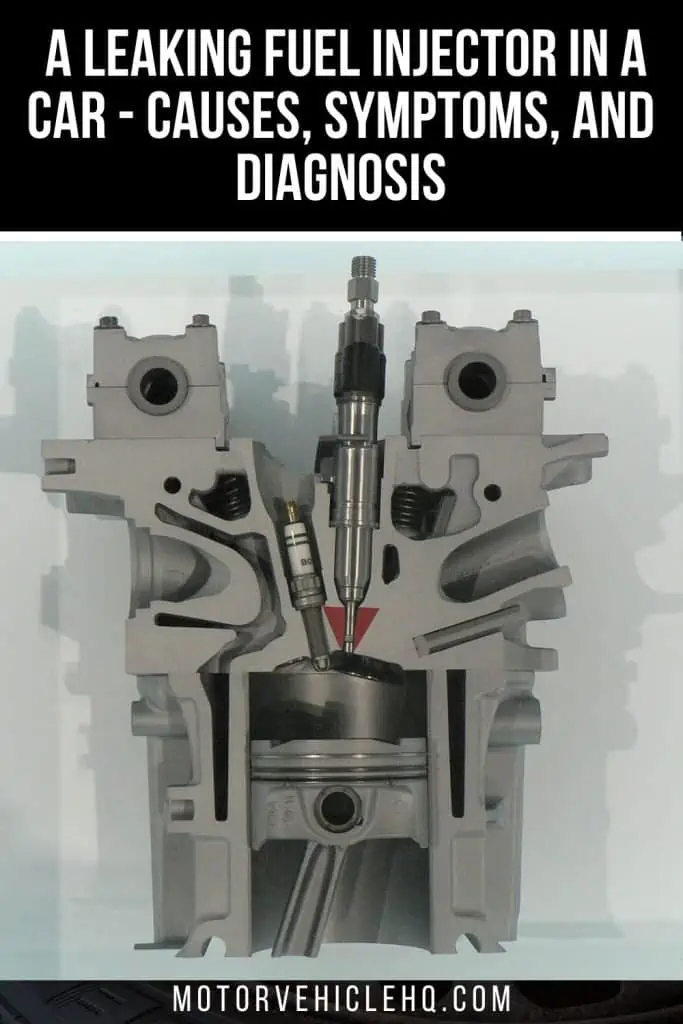The proper amount of gasoline is sprayed into your cylinder walls by the fuel injection system, which is an essential part that helps to complete the combustion process. The performance of your engine is impacted when your fuel injectors start or go bad, and various signs of a leaking fuel injector appear.
Lower gas economy, white smoke, misfiring, poor emission, unpredictable engine idling, and, in the case of a leak, engine banging are some of the symptoms. However, if a leak in an external fuel injector is not discovered quickly, it might start a fire. Who would want to have their vehicle burn?
Continue reading to find out how to inspect your engine for a leaking fuel injector to ensure it works smoothly and stop fires from starting due to external injectors and vacuum leaks.
A Fuel Injector: What Is It?
Before discussing the symptoms of a leaking fuel injector, it can be helpful to set the scene by explaining what this specific component accomplishes. What is a fuel injector and how does it operate, then?
As we previously said, the fuel injector is a tool that precisely and timely injects fuel into the engine. Keep in mind that an engine’s ability to operate depends on the combination of fuel and air.
Fuel injectors may be compared to syringes that dispense a predetermined amount of gasoline or diesel into the engine of your vehicle. A large portion of the fuel injected in excess will likely not be burned, resulting in waste.
On the other hand, if insufficient gasoline is injected, your vehicle won’t have enough power. The fuel injectors must make sure that they time their injection effectively in addition to the amount of gasoline they deliver.
An open image of a typical car fuel injector by Ton1~commonswiki / CC BY-SA 3.0. Fuel is accurately and promptly injected into the engine by the fuel injector. Remember that the mixture of gasoline and air determines whether an engine can run.
The ratio and combination of air and fuel delivered to the engine must be perfect for the best performance. In the end, this wouldn’t only have an impact on how well your vehicle performs.
Additionally, properly calibrated and functional fuel injectors may increase your engine’s fuel economy, dependability, and exhaust emissions. In terms of design and construction, fuel injectors are nothing more than quickly opening and closing valves.
How quickly might you ask? Fuel injectors may open and close numerous times per second, depending on your vehicle and the engine it utilizes. The injectors were always placed on the intake manifolds.
There, gasoline is combined with air that is flowing into the engine when the injectors spray fuel into the manifold. The engine receives this mixture of gasoline and air, compresses it, and then ignites it.
A Fuel Injector: How Does It Work?
- Your input is sent to the car’s main computer when you depress the accelerator pedal. The “engine control unit,” or ECU, is the name most frequently used to describe this.
- The position of the gas pedal will affect how much gasoline the ECU decides to feed into the engine. When you depress the accelerator pedal more firmly, the ECU recognizes that you require much more fuel to be pumped into the engine.
- The ECU will measure and analyze the rate at which air enters the engine at the same time. It will also determine the engine’s current speed, the condition of every other moving part, the amount of oxygen in the exhaust, and more. It can “read” this thanks to a variety of sensors that are dispersed all over your car.
- The ECU in your car will now calculate how much fuel to inject to achieve the ideal air-to-fuel ratio. They generally adhere to the 14.7:1 stoichiometric ratio in vehicles. This means that an ideal mixture requires 14.7 grams of air for every 1 gram of fuel.
- In the meantime, fuel is pumped from your fuel tank to the engine. The fuel pump then pressurizes it before transferring it to the fuel injectors.
- An electromagnetic solenoid in the fuel injectors moves a plunger to open the valves when all the necessary circumstances are met. This makes it possible for the fuel under pressure to spray out of the nozzle and into the intake manifold.
- This nozzle has an atomization design. Make sure the fuel isn’t just flushed into the intake manifold, to put it another way. Instead, it is dispersed as a very fine mist that can burn more quickly.
- Before entering the engine, the fine mist of gasoline or diesel is thoroughly mixed with the air rushing through the intake valves.
What Leads to a Leaking Fuel Injector In a Car?
Although fuel injectors typically last the entire life of the engine, poor driving practices and lack of maintenance can cause them to malfunction. Older, high-mileage vehicles are more likely to have a leaking fuel injector.
According to experts, there are typically two ways that lead to a leaking fuel injector. Either from the injector’s actual body or an O-ring.
BMW M88 engine with multi-point injection by Buschtrommler / CC BY-SA 3.0. For the engine to function at its peak, the ratio and mixture of the fuel and air provided must be ideal. In the end, this would affect more than just how efficiently your engine operates.
The injector must be entirely replaced if the damage is to the injector itself, such as corrosion or a crack. This kind of leak may result in harm to the injector’s body, pintle, ball, or disc seat. Hard stops and starts while driving can harm an engine and lead to this kind of leak.
O-rings that don’t fit properly, are fragile, or have damage may be the source of an o-ring leak. O-rings that are too old and improper maintenance lead to leaks of this kind, which over time cause parts to corrode, become brittle, and fail.
What are the Symptoms of a Leaking Fuel Injector In a Car?
Fuel injectors have been a part of diesel engines since the early 1930s. In the 1950s, gasoline engines switched from carburetors to injectors. Injectors were a common feature in almost every car when the 1990s came and went.
This is because there is an increasing need to reduce emissions while also enhancing fuel economy. They remain susceptible to failure even now.
Fair enough, most people don’t experience fuel injector failure very often. Having said that, there may be instances in which dirty fuel clogs your fuel injectors. Or, with enough time, use, and abuse, it might completely malfunction.
You will then begin to experience a few of the symptoms of a leaking fuel injector. So, this is what you might experience if you have a leaking fuel injector.
1. A Cylinder or More Does Not Fire, Causing Engine Misfires
If your fuel injector becomes overly dirty, becomes clogged, or breaks down, it essentially means that the engine’s fuel supply has been interrupted. It’s possible that the injectors won’t even provide fuel to the engine. It could also spray fuel inattentively, ineffectively, or unreliable, starving your engine of fuel.
It makes sense that your car would begin to drive poorly, and you can immediately tell. Constant engine misfiring is one of the symptoms of a leaking fuel injector. Your car’s engine won’t run as well if there isn’t enough fuel or even any fuel at all.
Misfires occur when one or more of the engine’s cylinders don’t ignite or burn simultaneously. Let’s say you have an inline-6 as an illustration. There are 6 cylinders in the engine, and a misfire could render two of them inoperable. As a result, you are currently only using 4 cylinders.
2. Rough Idling with the Sound and Feel of the Engine Rougher When Idling
Once more, the fuel supply is a factor in this leaking fuel injector symptom. Your injector is unable to supply fuel to the engine because it has failed or become clogged. As an alternative, it might spray the fuel inconsistently or at the incorrect time. However, the fuel circulation is not optimal.
You might be able to hear the engine running rough while it’s idling. This is because during idle, the RPM falls below the optimum level for the fuel injectors to operate efficiently. Fuel injectors that are working properly can operate over a wide RPM range, so this is typically not a problem.
However, when it is idle, your engine’s revolutions per minute (RPM) fall to between 600 and 1,000. A leaking fuel injector will find it difficult to feed your engine with fuel at these low RPMs. As a result, you’ll start to notice that the engine is shaking or vibrating more than usual when it’s idle.
Rochester manifold fuel injection by Thilo Parg / CC BY-SA 3.0. The injectors spray fuel into the manifold, where it is mixed with the air entering the engine.
Your RPMs fluctuating quickly is another thing you might notice during a rough idle. Additionally, the sound would be audible more when the engine is idle. The engine may also stall while your car is idle if your fuel injectors are even worse than expected.
3. The Engine Vibrates As It Shakes, Shuffles, and Knocks
This reinforces our earlier observation that clogged or leaking fuel injectors result in insufficient fuel being delivered to the engine. One, some, or all of the cylinders can’t fire efficiently if there isn’t enough fuel. The engine will begin to vibrate, shake, shudder, and quiver once it has finished the entire combustion cycle.
This will be very obvious to you because your car will feel and operate much more uncomfortable than it did before. Additionally, the engine may start to make audible knocking noises. If you are driving a turbocharged vehicle, this is a particularly significant symptom of a leaking fuel injector to watch out for.
Compared to their naturally aspirated counterparts, turbocharged engines typically operate hotter and harder. Turbocharged engines need a lot more fuel to run at higher RPMs. Vibrations can be produced by the engine detonating quite literally if there is not enough fuel or if the turbo engine becomes too hot.
4. Surges In Engine Power with Continual Fluctuation In RPMs
A Leaking fuel injector could have the exact opposite effect of not having enough fuel in the engine. To put it another way, the engine may be sprayed with too much fuel if the injectors are failing or malfunction. Similar to that, this isn’t ideal because the engine has more fuel than it needs.
You might be able to feel the engine gain power if the injectors are spraying too much fuel into it. Your engine’s inability to burn or ignite extra gasoline or diesel is referred to as a surge. Slow acceleration and a loss of power are two effects of this.
Surges will also have an impact on the RPMs. Your RPM should be constant, staying at a predetermined RPM when the load is constant, such as when driving at a constant speed on the highway. However, the RPM will fluctuate a lot because the fuel injectors are producing a surge. That holds even when a constant force is used.
5. The Check Engine Light on Your Dashboard Illuminates
The check engine light (CEL) appearing on your dashboard is another obvious indication that something is wrong with your car. Many sensors are used in contemporary vehicles to enhance not only the performance of specific components. Additionally, they could assess their health.
Your engine’s efficiency, performance, and operation will suffer as your fuel injectors wear out. The numerous sensors that keep track of the diverse set of engine components can easily be tripped by this. The ECU will gather this error data as soon as the sensors identify a problem.
The ECU will then signal your dashboard’s check engine light to turn on if your car isn’t operating at its best. It serves as a warning to get your car checked out and take a closer look at what might be wrong. Unfortunately, it cannot direct you specifically to the issue.
It is impossible for a single static, blinking, or flashing warning light to illuminate all potential faults. Even when minor issues are found, the check engine light will come on. For instance, the gas cap may not be properly tightened.
Thank goodness, the ECU does have a ton of error codes stored in its memory. These fault codes will be kept as it powers on, and you may study them to learn more about why they originally occurred. These error codes may be extracted and viewed using an OBD diagnostics tool.
An electronic control unit (ECU) for a car by Specious / CC BY-SA 3.0. If your automobile isn’t performing at its best, the ECU will then send a signal to your dashboard’s check engine light to switch on.
With these codes, you might then explore the web and learn more about why it’s occurring.
6. Fuel Leakage That Is Noticeable By Scent or Is Visible
Your fuel injectors may start failing or splitting if they are a little older. In many cases, the injector seals rather than the housing are the main source of failure. In either case, gasoline might begin to escape from the injectors. This poses a major risk in addition to being inefficient and bad for performance.
Typically, you may see evidence of diesel or gasoline spilling onto the fuel rail. You could even see drops of it on the intake manifold itself. Even if there isn’t any obvious leaking, you could still be able to smell it. Determine where the scent is originating from because gasoline and diesel have powerful smells.
Mind you, the aroma could not even originate in the engine compartment. Raw gas or diesel will escape the tailpipes if there is unburned fuel present as a result of a leaking fuel injector. There can also be a petrol smell. This needs to be corrected right away because otherwise, your vehicle may catch fire.
7. A Bad Fuel Economy with Lower Than Usual MPG
Your MPG numbers will inevitably be affected by the erratic flow of gasoline into your engine caused by leaking fuel injectors. There are two options available here:
- Fuel is sprayed into the engine in excess by a leaking fuel injector, which raises your fuel usage.
- Or perhaps the engine isn’t getting enough gasoline because of a leaking fuel injector. To make up for this, the ECU is forced to ask the other, healthy injectors to spray far more gasoline.
Your MPG will start to tank as much more gasoline is pushed into the engine. Granted, it can take some time for you to notice this, depending on how much the fuel injectors are leaking. Your MPG may or may not be significantly affected, depending on how much the injectors leak.
8. Emissions Test Failure with Unburned Fuel Coming from the Tailpipes
Incomplete combustion is one of the effects of a leaking fuel injector. In other words, the fuel is not being consumed completely. This is the situation if the engine’s injectors are pouring in more fuel than it can manage or ignite at once.
The unburned gasoline may only exit the vehicle through the exhaust. Because you are effectively using up liquid fuel, unburned gasoline will cause a significant increase in your carbon emissions. As a result, if you were to take your vehicle for its routine emissions test, it may fail right away.
In some cases, the fuel injectors may also leak continuously into the engine. Your air-to-fuel mixture will become extremely rich as a result (too much fuel, too little air). It could be hot and poisonous enough to burn up your catalytic converters because the combination is so rich in it.
What Techniques Can You Use In Checking for a Leaking Fuel Injector?
The most typical sign of an externally leaking fuel injector is a “gas smell that gets into your vehicle.” Here is a crucial manual for doing the fuel injector leak test.
Black unburned gas from the exhaust by Ruben de Rijcke / CC BY-SA 3.0. If unburned fuel is present due to a leaky fuel injector, raw gas or diesel will exit the tailpipes.
What will happen if a fuel injector leaks? For instance, your fuel injectors at numbers three and four are leaking while those at numbers one and two are not.
The result will be that one, two, or three injectors won’t spray enough gasoline into the cylinder. The computer will tell the ECM to cut back on how much fuel the fuel injectors are sprinkling.
Since the ECM won’t be able to pinpoint the precise injector that is spraying too much fuel, it will lower the amount of fuel that all of the injectors are spraying. The ECM has decreased the appropriate quantity of fuel that the non-leaking injectors are spraying, which will cause insufficient fuel flow from cylinders no. 1 and 2.
Your computer will keep a misfire code in the system when this occurs. Codes for cylinders 1, 2, 3, and 4 are P0301, P0302, P0303, and P0304, respectively.
The computer will translate a misfire as soon as it modifies the spraying rate of injectors that aren’t leaking. From this point, there may be several variants. It’s crucial to understand how your injectors function and how they’ll impact your engine, though.
So let’s go right to step-by-step instructions.
Step 1
Start your engine, and while it is idling, check each fuel injector for leaks. Your fuel injector O ring may be the source of any outside leaks. If so, you’ll need to replace the broken ones with a new o ring.
Step 2
Remove the negative connection from your car’s battery after turning off the engine. If your air filter box is obstructing you, loosen the bolts keeping it in place.
Step 3
Disconnect your throttle cable or unhook your throttle socket, depending on your vehicle model. Make sure you carefully remove all the cables in your path.
Step 4
Your injectors’ socket should be disconnected. Remove the fuel rail’s bolts, then use an injector remover to carefully take the rail off. To perform this test correctly, you must make sure that the fuel lines are still attached to the fuel rail so that the fuel pump can produce sufficient gasoline pressure.
Step 5
Get a milliliter-sized syringe or similar device to test the fuel’s pressure.
Step 6
Test the voltage on your injector sockets using your multimeter. Injectors often have two pins on them. A range of 3.70 and 3.89 is acceptable. There shouldn’t be any deviations over that.
Step 7
Look closely at your fuel fuse after removing it to reveal PIN 87 and 30, which are the primary fuel lines (these numbers may differ from car to car). To maintain a consistent flow of gasoline, touch the fuse.
The check engine light dashboard warning by Wikiuser100000 / CC BY-SA 3.0. Another clear sign that anything is amiss with your automobile is when the check engine light (CEL) comes on on the dashboard.
Step 8
Send current to your injectors and check each one’s particular spraying rate. To gauge the amount of gasoline entering the container during this operation, I asked you to use a tool like a syringe with milliliters numbering on the body.
You can choose to let the gasoline reach 30 to 50 milliliters; the bigger the amount, the more probable it is that the measurement will be correct.
Step 9
It is ideal to time how long it takes each injector in this testing model to fill a milliliter container. You can use any container if a milliliter container is not available for this test. You must, however, pay special attention to the spraying rate.
The spraying process needs to be efficient. You shouldn’t observe large droplets erupting. Any injector that is spitting out extra fuel is leaking, therefore you should pay attention to it.
What Is a Fuel Injector Leak-Down Test and How Is It Done?
A fuel injector leak-down test may be completed relatively easily. Car engines with port Schrader valves can use this technique. Installing an EFI gauge kit for a performance fuel system is the most straightforward method to complete this operation.
Install the EFI gauge kit, turn on your car, let it idle for 20 to 45 minutes, then check for fuel injector leaks. Make sure you pay special attention to the fuel pressure.
The ideal pressure range is 35 to 50 psi. Watch the fuel pressure fall as the engine is turned off. A rapid decrease in pressure of 2 psi per second suggests a problem. Much slower is perfectly acceptable.
How Can You Fix a Leaking Fuel Injector?
You must examine the injector regions to determine whether there is any leak, just like you would while looking for a leaking fuel injector. Your injectors are externally leaking if the area around them is damp.
First things first, unplug your batteries to prevent a spark after checking your injectors for outside leaks. Remove the screws holding your air box from the way using the appropriate toolkits.
Depending on your vehicle type, loosen the bolts keeping your throttle body in place, unhook the socket or throttle cable, and remove the water and air hoses that are connected to it.
All the plugs and wires along the route should be carefully unplugged. Make sure you clear any obstructions in the area by taking a look around. Injector sockets should be unplugged slowly to prevent damaging the fitting pins.
Examine your injectors for any outside leaks with your under-the-hood work light. A leaking fuel injector o ring is most likely the source of any gasoline around your injector locations.
Loosen the bolts holding the fuel rail, carefully remove them, and examine each o ring separately. You must get new o rings and swap out the broken ones if the o ring has any effect on it.
If you have original o rings that will last the test of time, you may replace all of them at once. Broken o rings might result in air leaks from the injectors, which will impair the performance of your engine.
Use the following step-by-step instructions to check for internal fuel injector leaks; if you discover any, purchase a new injector and replace it. Although the cost to fix a leaking fuel injector varies, fuel injectors are still reasonably priced.
A faulty o-ring is the main cause of fuel injector leaks. The injector is usually entirely changed when only the O-ring has to be changed.
You can fix a leaking fuel injector for between $600 and $1,250, depending on the type and make of your vehicle. A new fuel injector will cost between $400 and $900, and servicing charges will be between $200 and $250.
Change an O-Ring on a Leaking Fuel Injector
The majority of leaking fuel injectors are due to a bad o-ring. When only the O-ring is required to be replaced, the injector is frequently completely changed. They are more affordable! Since labor will account for the majority of the cost of replacing an o-ring, your expenses will be more influenced by local prices.
Experts compute the cost by adding the typical cost of $30 to $75 for parts and your local labor rate for two hours.
You may also do this yourself if you know how to operate your car. Since the injectors are all held in place by the same rail, we advise changing all the o-rings if you replace one. Since your parts will experience the same wear and tear in the future, maintenance will be simpler.
To determine what kind of o-ring kit to buy, check your vehicle’s handbook to discover what kind of engine you have. Additionally, you may use the fitment checker at the top of any Amazon page for automotive components to determine whether the O-ring you are interested in will fit your car.
Is It Safe to Drive a Car with a Leaking Fuel Injector?
You can drive your vehicle for a few kilometers even if it has interior leaks. This doesn’t imply that your vehicle won’t get you around; it will. However, it will significantly reduce your engine’s efficiency.
If you see exterior leaks, carefully choose a secure location and store your vehicle there. If you keep driving your vehicle while it has external fuel injector leaks, a fire will quickly break out.
What Is the Lifespan of a Fuel Injector?
Experts in the field of vehicles claim that the fuel injector has a comparatively long lifespan of up to 100,000 kilometers. It’s crucial to bear in mind that this figure fluctuates based on the gasoline type and frequency of fuel filter replacements you employ in your car.
For instance, utilizing better and cleaner gasoline will prevent clogging, which in turn prevents the fuel injector from being damaged. Similar to replacing the fuel filter frequently, this will stop dirt and debris from getting into the fuel injector and harming it.
How Can You Minimise Leaking Fuel Injector Problems In Your Car?
You may now choose whether to fix the leak yourself or obtain a mechanic’s estimate now that you are aware of the symptoms to watch out for when diagnosing your fuel injector difficulties and what you can do about it.
The gasoline system should be inspected and cleaned every 3,000 miles, according to common wisdom. Your injectors will continue to function for years to come with regular cleanings and maintenance, which prevent blocked injectors from becoming a more serious issue.
The Conclusion
As you’ve seen, a leaking fuel injector can result in dangerous fires and serious engine issues. Make careful to correct gasoline leaks as soon as you find them to avoid harming your car’s engine.
You have been successfully guided through the process of finding points on a leaking fuel injector and fixing them. Please feel free to leave any comments or questions in the comment section.
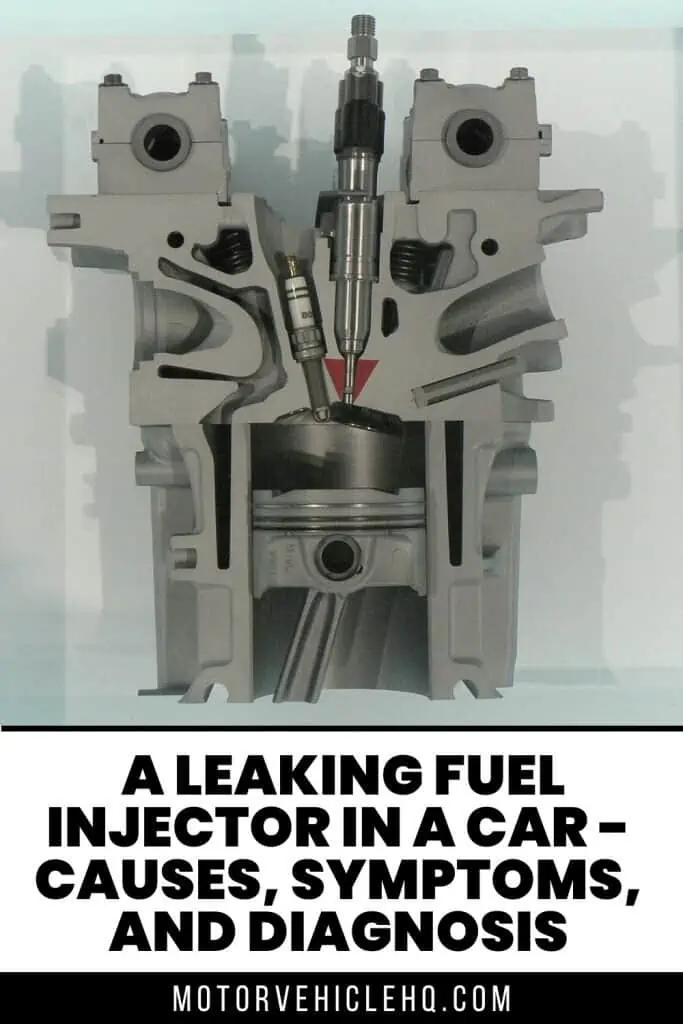
An open image of a typical car fuel injector by Ton1~commonswiki / CC BY-SA 3.0

Jim Wicks is the founder of MotorVehicleHQ. With over two decades of experience in the automotive industry and a degree in Automotive Technology, Jim is a certified car expert who has worked in various roles ranging from a mechanic, car dealership manager, to a racing car driver. He has owned more than 20 cars over the past 15 years. Ask him about any vehicle you see on the road and he can tell you the make, model and year. He loves the aesthetics of all things cars, and keeps his vehicles in pristine condition.
In his free time, Jim enjoys getting his hands dirty under the hood of a classic car or taking long drives along the country roads. His favorite car? A 1967 Shelby GT500, a true classic that, according to Jim, “represents the pure essence of American muscle.”

